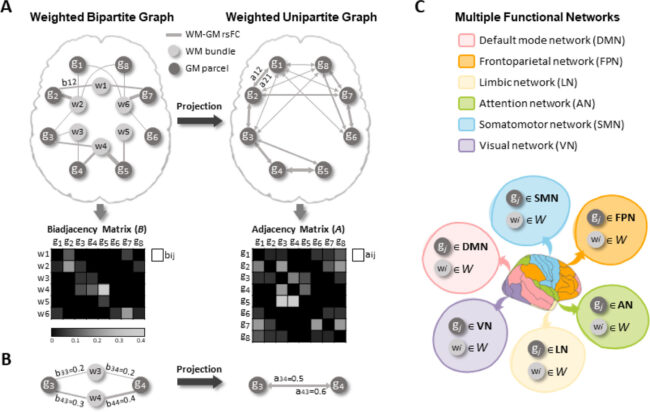Functional alterations in bipartite network of white and grey matters during aging
Yurui Gao, Yu Zhao, Muwei Li, Richard D Lawless, Kurt G Schilling, Lyuan Xu, Andrea T Shafer, Lori L Beason-Held, Susan M Resnick, Baxter P Rogers, Zhaohua Ding, Adam W Anderson, Bennett A Landman, John C Gore.
Paper: https://pubmed.ncbi.nlm.nih.gov/37473978/
Abstract
The effects of normal aging on functional connectivity (FC) within various brain networks of gray matter (GM) have been well-documented. However, the age effects on the networks of FC between white matter (WM) and GM, namely WM-GM FC, remains unclear. Evaluating crucial properties, such as global efficiency (GE), for a WM-GM FC network poses a challenge due to the absence of closed triangle paths which are essential for assessing network properties in traditional graph models. In this study, we propose a bipartite graph model to characterize the WM-GM FC network and quantify these challenging network properties. Leveraging this model, we assessed the WM-GM FC network properties at multiple scales across 1,462 cognitively normal subjects aged 22-96 years from three repositories (ADNI, BLSA and OASIS-3) and investigated the age effects on these properties throughout adulthood and during late adulthood (age ≥70 years). Our findings reveal that (1) heterogeneous alterations occurred in region-specific WM-GM FC over the adulthood and decline predominated during late adulthood; (2) the FC density of WM bundles engaged in memory, executive function and processing speed declined with age over adulthood, particularly in later years; and (3) the GE of attention, default, somatomotor, frontoparietal and limbic networks reduced with age over adulthood, and GE of visual network declined during late adulthood. These findings provide unpresented insights into multi-scale alterations in networks of WM-GM functional synchronizations during normal aging. Furthermore, our bipartite graph model offers an extendable framework for quantifying WM-engaged networks, which may contribute to a wide range of neuroscience research.
